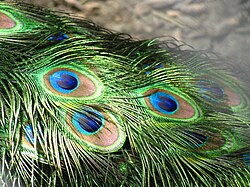Structural color

Structural coloration is a coloring that results from the special structure of the surface. Sometimes structural coloration is combined with pigments: for example, peacock tail feathers are pigmented brown, but their structure makes them appear blue, turquoise, and green, and often they appear iridescent.[1][2]
English scientists Robert Hooke and Isaac Newton were the first who observed structural coloration. Thomas Young described its principle a century later and called it wave interference. Young described iridescence as the result of interference between reflections from several surfaces of thin films, combined with refraction as light enters and leaves such films. The geometry then determines that at certain angles, the light reflected from both surfaces adds (interferes constructively), while at other angles, the light subtracts. As a result, different colors appear at different angles.
Structural Color Media
Robert Hooke's 1665 Micrographia contains the first observations of structural colours.
In 1892, Frank Evers Beddard noted that Chrysospalax golden moles' thick fur was structurally coloured.
Electron micrograph of a fractured surface of nacre showing multiple thin layers
Butterfly wing at different magnifications reveals microstructured chitin acting as a diffraction grating
Drawing of 'firtree' micro-structures in Morpho butterfly wing scale
Structural coloration through selective mirrors in the emerald swallowtail
Magnificent non-iridescent colours of blue-and-yellow macaw created by random nanochannels
References
- ↑ Hooke, Robert. Micrographia. Chapter 36 ('Observ. XXXVI. Of Peacoks, Ducks, and Other Feathers of Changeable Colours.')
- ↑ Ball, Philip (May 2012). "Nature's Color Tricks". Scientific American. 306 (5): 74–79. Bibcode:2012SciAm.306e..74B. doi:10.1038/scientificamerican0512-74. PMID 22550931.







